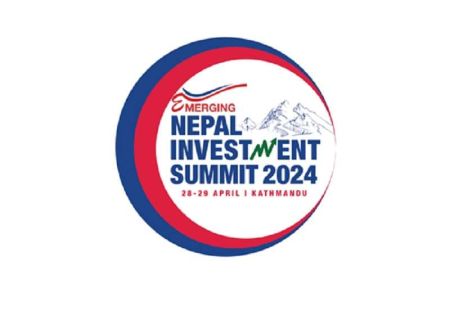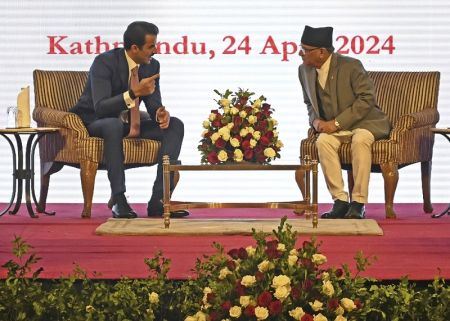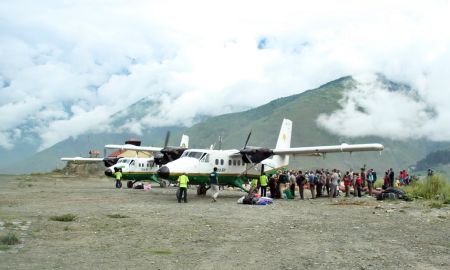.jpg)
Everest Bank, the Nepal arm of India's Punjab National Bank was founded in 1994 and has 50 Branches, 73 ATM Counters, 5 extension counter and 22 Government Revenue Collection counters across the country making it a very efficient and accessible bank for its customers, anytime, anywhere. It is the first bank to start ABBS (Any Branch Banking System) in Nepal and has come up with various credit and deposit banking schemes. In an interview with Siromani Dhungana and Angila Sharma of New Business Age, AK Ahluwalia, CEO of Everest Bank shared his views on the bank’s performance as well as the overall banking system of Nepal. Excerpts:
It has been nearly a year that you are CEO at EBL. How has been the experience?
It has been a good experience, though in very challenging times. When I landed here, the elections had been announced and the country went into election mode. It has been a period of transition for the country as a whole. Simultaneously, there was also issue of dollar appreciating at a very high rate, which resulted in increase in value of the remittances and the market was flushed with liquidity. So, as a whole, the last nine months have been a period where all of us have been combating excess liquidity effect while not losing sight on growth as both have to go hand in hand.
Can you please share with our readers your observation about the strengths and weaknesses of Nepali Banking system?
I have been in touch with most of the bankers and have been consistently discussing the issues in the forums available to us. I have also gone around the country to visit my branches which are spread all over the country. My personal opinion is that Nepal is a country where banking is still young. The banks are very receptive to new ideas. There is no rigidity involved in their approach. Basically, these are the strengths of Nepali Banking sector as they are ready to evolve into strong institutions with fresh ideas and also to imbibe the best practices around the world.
Regarding the weaknesses, the banking is still in an evolving and consolidation stage. This will take its own time because evolution is a gradual process. The Nepal Rastra Bank is trying to introduce and encourage the best practices from all over the world.
Your key expertise is said to be in credit and recovery. What innovative ideas did you introduce in these areas in Everest Bank?
Credit, basically, is a function of delivery and growth. Once the entrepreneurs decide that they have to expand their units or establish new units, only then the credit off-take happens. The last nine months have not been very conducive for this. Many entrepreneurs were adopting a policy of wait and watch. They were not coming out with expansion plans or setting up of new units. However, with the stabilization process in motion, I believe once we are in expansion mode and new units come up, we too will be coming up with new products. As for our immediate plans, one is that we are planning to have a database of various industries. With our experience of working elsewhere and the information available in the network, we will be able to guide the future entrepreneurs and even our existing borrowers regarding any particular project which they want to go into. We will be guiding them about the precautions and necessary remedial steps to be taken.
What’s your say regarding mandatory lending provisions imposed by NRB, e.g. investment in agro and hydro sector?
As far as we are concerned, we are already financing agriculture. We have our specialized agriculture branch in Rajbiraj. Besides that, we have a number of branches in the Terai belt that are doing agriculture financing in a big way. They had been doing it even before the mandatory stipulation and are successful in their endeavour.
These sectors are very crucial for the economy of the country. Hydro is the need of the hour. We are going through a phase where we have to bear the burden of 12 hours load-shedding. We have huge hydro resources but we are not using them neither for own use nor for selling electricity to neighbouring countries. So, I believe mandatory provisions are required and should continue till the banks themselves get used to financing these required sectors. At that point, this 10 to 12 per cent stipulation won’t matter. It will motivate banks to do much beyond that allocated percent.
Another problem is that there are not many industries as of now. It is basically a trading economy. Most of the goods are being imported from outside and sold here. Rapid industrialization is yet to occur. The remittances that come from outside are mainly used for consumption purpose. So, if we don’t have this mandatory stipulation, the smaller and new banks may not be financing the required sectors and would be comfortable in doing only trade finance.
Speaking with us, Reserve Bank of India’s former governor Dr. Duvvuri Subbarao underlined the need that the banking system should adopt the principle of financial inclusion to avert crisis in banking sector. Do you think that Nepal’s banks are working honestly for financial inclusion?
Given the size of the population and geographical nature of the country, I think financial inclusion is yet to take place completely. In any case, it is an ongoing process. From my experience in India, I can say that it is not very easy. Initially, despite the large network of banks in India, some of the banks were not interested in financial inclusion. So, it was enforced. Yes, Dr. Subbarao is very right and so is our governor Dr. Khatiwada. I think he also believes that financial inclusion has to take place. Unless and until all the people are under the banking network, I don’t think any growth can take place. Growth always has to be inclusive. It cannot be centered only in a few cities or in few people. In Nepal, the problem arises because of geographical situation. There are areas where the population size is of a few thousand or even few hundred. The villages are also very spread out in the hill areas. I think that financial inclusion has to reach to those areas also. They have to be a part of our banking network for the sake of all inclusive growth. It can be done by rolling out the banking service to them. Ultimately, they have to be a part of the network.

Everest Bank had a plan to replicate across the country the Rajbiraj branch to provide specialized lending for agriculture sector. What is the progress in this so far?
We have been progressing on this. Besides Rajbiraj, a number of branches have been financing agriculture now. Branches in Biratnagar, Birtamod, Damak and Simara are few examples. It is quite successful because the adopted model is of financing through cooperatives, which is successful because you finance through cooperatives and also recover through cooperatives.
How do you rate the success of Everest Bank in the scheme called ‘Freedom Account’ under which debit cards are provided to school children?
The number of accounts under the freedom scheme has reached 17 thousand. For the first time in Nepal, Everest Bank brought a scheme where a minor is allowed to operate his/her account independently and it has been very effective. The basic motive behind this was that children should get the habit of saving. The tendency is to spend whatever you get. So, we are trying to develop saving habit from an early age to help them in the future. Not only that, we are also giving education loans. This is interlinked with the freedom account. On one hand, they get used to deposit, however small that may be, and on the other hand, we are financing their education.
Everest Bank’s earning per share, average yield on loan and advances and return on equity have gone down as per the Q2 financial report of this year compared to the last year. How improved is the Q3 report going to be?
The return has not gone down, only it is reflected as such as we issued bonus shares. We issued bonus shares in Ashadh last year to our shareholders. When the number of shares increases, the return appears to have gone down but we have to take into account the enhanced value that bonus shares have created.
Most of the banks in Nepal seem to be focused more on interest income and Everest Bank too seems to be following same strategy. What is hindering the banks from increasing their focus on non-funded businesses?
In a trading economy, interest is the main income. So, unless the export really picks up, it is really difficult to increase our non-interest income. I think that it will pick up in the coming years. In Nepal, the exports are much less compared to the imports. Once the exports pick up, the non-interest income of the banks will also increase.
What is Everest Bank doing about merger and acquisition that NRB is encouraging so seriously?
Banks are being encouraged to do that and NRB has come out with guidelines too in this regard. However, there is no such plan in our bank at this moment.
What are the plans of Everest Bank for the coming months and the next year?
We are opening some more branches in a couple of months and we hope to expand further. The idea is to go to untapped areas where we have not reached yet. We want to increase our business. Our staff members are putting a lot of effort on this. With the support of our customers, borrowers, depositors and highly motivated team of staff members, we have been able to strengthen our business substantially. Now, we also plan to come up with some credit schemes targeting specific sectors. We have been targeting the retail segment for some months and it has also helped in expanding our base. Moreover, retail is a long term commitment. Besides, it also helps in adding more customers. The idea is to expand our business and take bank to new heights.





















